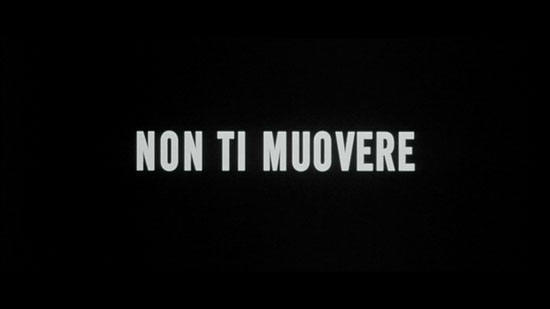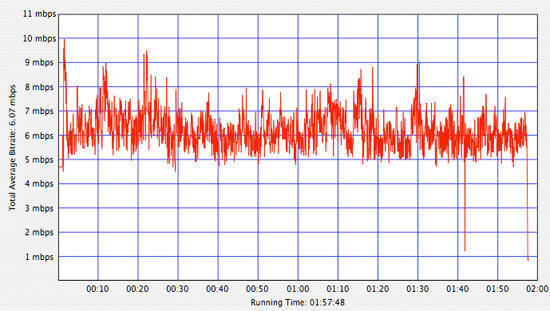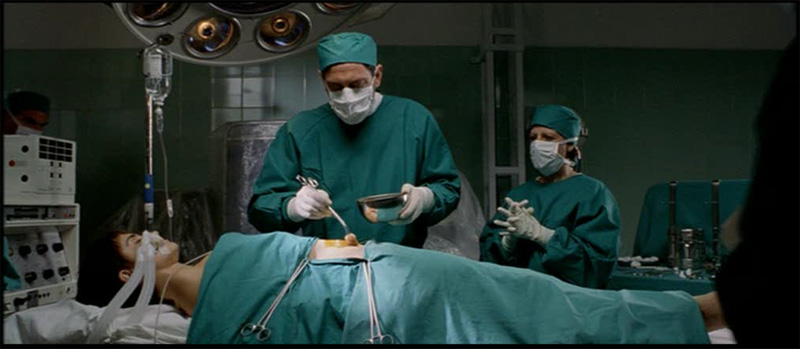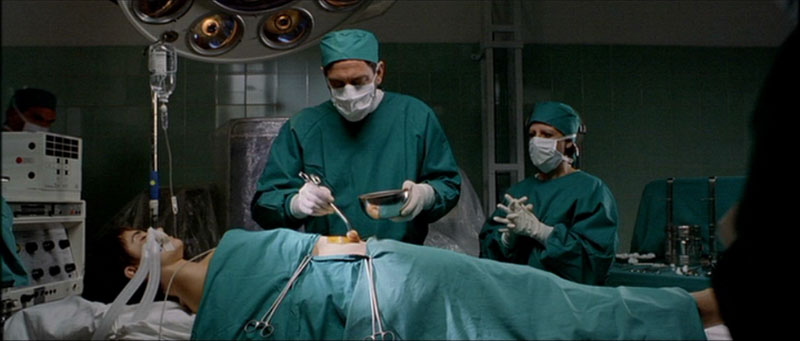![]()
![]()

![]()
![]()

(aka "No te muevas" or "Don't Move")
directed by Sergio Castellitto
Italy / Spain / UK 2004
Say what you will about Penelope Cruz’s
less challenging roles in American films, but her work in foreign cinema
has rarely failed to impress me. If there’s a single person to thank,
the talented actress is obviously indebted to writer/director Pedro
Almodovar for providing her with colorful and spirited characters since
her brief role in “Live Flesh” (1997). Although Cruz chose to work in
the more profitable Hollywood system after the international success of
“All About My Mother” (1999), she recently collaborated with Almodovar
again in the Cannes’ favorite “Volver” (2006). Critics universally
lauded her performance, and she was awarded the female acting prize
jointly with a cast of Almodovar regulars. Though Cruz is frequently
noted for her collaborations with Almodovar, she conveyed a noteworthy
performance in 2004’s “Don’t Move” that received praise from the
international press. However, due to the film’s unpleasant subject
matter, it failed to find an audience in North America.
“Don’t Move,” at its core, is a soap opera with plenty of sex and
nudity. Dr Timoteo Rossi (Sergio Castellitto) is haunted by a tragic car
accident involving his daughter, Angela (Elena Perino). Left comatose by
a near-fatal head injury, Angela lies lifeless and bed-ridden. Her poor
condition encourages Timoteo to reconsider his own life and a past
affair. Before his daughter was born, Timoteo was lost in his marriage
and found solace in an affair with a hotel maid, Italia (Penelope Cruz).
Timoteo considered leaving his wife, Elsa (Claudia Gerini), for Italia,
but Elsa became pregnant with Angela. A bitter end to his relationship
with Italia ensued, and Timoteo returned to his family. In light of the
recent tragedy, Timoteo desperately recalls memories of his true love
for comfort and inspiration.
If you’ve seen “Monster” (2003), I’m sure you’re aware that it’s quite a
difficult task to forget the images of Charlize Theron’s grizzly
transformation into a murderous prostitute. In “Don’t Move,” Penelope
Cruz proceeds through a vaguely similar transformation as a
poverty-stricken woman haunted by experiences of rape and an abusive
childhood. Where Theron’s performance is overstated and perhaps too
exaggerated for the film’s good, Cruz is alternately detached and
occasionally intense at opportune moments. Her approach to her
character’s sexuality clearly signals an unpleasant past, and it’s
particularly in the small moments, with a patient and heartfelt
disposition, that Cruz offers a profoundly layered characterization.
It’s remarkable that Cruz can convey so much history in a character
without saying a single word.
Keep in mind that I am in no way demeaning Theron’s performance; rather,
I’m suggesting another example of a vastly different approach to method
acting--one that, in my opinion, is superior. In these two films, each
forcefully driven by female lead performances, it was Theron’s
performance that was universally acknowledged while Cruz’s remains an
afterthought.
“Don’t Move” is adapted from a novel written by Margaret Mazzantini. The
novel has been a substantial commercial success and is an international
bestseller. However, the novel was also known for its melodramatic
subject matter--a problem that developed into the film’s major flaw.
Mazzantini’s prose flows brilliantly, and her lush descriptions
enrapture and connect the reader with her characters. The film is forced
to compromise certain aspects of the novel. Star, writer, and director
Sergio Castellitto attempts to compensate for the film’s plot with a
sumptuous visual style, which is well complimented by Cruz’s
pitch-perfect performance and his own demanding take on a character with
severe emotional instability. Nonetheless, amidst all the emotional
intensity is a story that is underdeveloped and plagued by awkward
staging (re: the use of music and in particular Europe’s “The Final
Countdown”). It’s almost immediately obvious that the film is weakened
by a lack of logical character motivations--particularly when Timoteo (Castellitto)
relates his inconsistent life philosophies. Unfortunately, Castellitto
has misplaced his attempts to invoke a need for empathy and
understanding for his characters, and consequently, “Don’t Move” is a
relatively hollow experience.
Apparently, there was a big fuss from the producers of “Don’t Move” when
Penelope Cruz failed to be nominated for Best Actress at the Academy
Awards. Their cause may be justified given the gravity of Cruz’s
performance, but realistically, the Academy rarely acknowledges
actresses in foreign films. Taking into consideration all the talent
involved (especially Cruz), it’s really a shame that the film doesn’t
become what everyone involved would have hoped, especially when nothing
substantial has materialized for Castellitto since this film’s release.
Posters
 |
 |
 |
Theatrical Release: March 12, 2004 (Italy), December 17, 2004 (USA)
Reviews More Reviews DVD Reviews
DVD Comparison:
Medusa (2-Disc Special Edition) - Region 2 - PAL vs. Wellspring - Region 1 - NTSC
Big thanks to Per-Olof Strandberg and Kurtis Beard for the Screen Caps!
(Medusa (2-Disc Special Edition) - Region 2 - PAL - LEFT vs. Wellspring - Region 1 - NTSC - RIGHT)
| DVD Box Covers |
|
|
| Distribution |
Medusa Region 2 - PAL |
Wellspring Region 1 - NTSC |
| Runtime | 1:57:48 (4% PAL Speedup) | 2:01:50 |
| Video |
2.35:1 Original Aspect Ratio
16X9 enhanced |
2.35:1 Original Aspect Ratio
16X9 enhanced |
|
NOTE: The Vertical axis represents the bits transferred per second. The Horizontal is the time in minutes. |
||
|
Bitrate:
Medusa (2-Disc Special Edition)
|
|
|
|
Bitrate:
Wellspring
|
|
|
| Audio | Italian (Dolby Digital 5.1, Dolby Digital 2.0) |
Italian (Dolby Digital 2.0) |
| Subtitles | English, French, Italian HoH, None | English, none |
| Features |
Release Information: Studio: Medusa Aspect Ratio:
Edition Details: Chapters 36 |
Release Information: Studio: Wellspring Aspect Ratio:
Edition Details:
DVD Release Date: July 18,
2006 Chapters 12 |
| Comments |
RE:
Medusa (2-Disc Special Edition) - I
can't image that this film can look any better on DVD than this
R2 disc from Medusa. It's stunning! The only second, that the
picture didn't look like a cinema print, was a short image of a
front of a car. It had a brief Moire effect. And that's a very
little fault in a two hours film! It's a pity that the extra material is not subtitled in English. ADDITION: Wellspring - Region 1- NTSC (August 06'): Video: |
DVD Menus
|
|
|
|
|
|
 |
 |
|
|
|
|
|
|
Screen Captures
(Medusa (2-Disc Special Edition) - Region 2 - PAL - TOP vs. Wellspring - Region 1 - NTSC - BOTTOM)
|
|
|
|
(Medusa (2-Disc Special Edition) - Region 2 - PAL - TOP vs. Wellspring - Region 1 - NTSC - BOTTOM)
|
|
|
|
(Medusa (2-Disc Special Edition) - Region 2 - PAL - TOP vs. Wellspring - Region 1 - NTSC - BOTTOM)
|
|
|
|
(Medusa (2-Disc Special Edition) - Region 2 - PAL - TOP vs. Wellspring - Region 1 - NTSC - BOTTOM)
|
|
|
|
(Medusa (2-Disc Special Edition) - Region 2 - PAL - TOP vs. Wellspring - Region 1 - NTSC - BOTTOM)
|
|
|
|
(Medusa (2-Disc Special Edition) - Region 2 - PAL - TOP vs. Wellspring - Region 1 - NTSC - BOTTOM)
|
|
|
|
(Medusa (2-Disc Special Edition) - Region 2 - PAL - TOP vs. Wellspring - Region 1 - NTSC - BOTTOM)
|
|
|
|
Report Card:
|
Image: |
Wellspring |
|
Sound: |
Medusa |
| Extras: | Medusa |
| Menu: | Medusa |











































